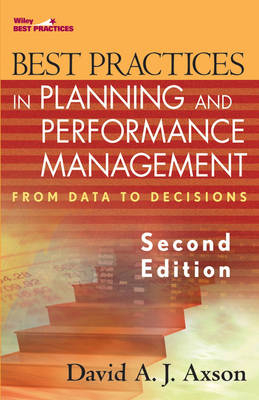
Best Practices in Planning and Performance Management
John Wiley & Sons Ltd (Verlag)
978-0-470-00857-7 (ISBN)
- Titel erscheint in neuer Auflage
- Artikel merken
"Having worked closely with David Axson, I have seen his strategic brilliance firsthand. The integrated approach he takes in practice synthesizes external dynamics, business process, planning, systems, and management for effective execution. "Best Practices in Planning and Performance Management, Second Edition" brings his keen insight to life, presenting a comprehensive approach to managing business dynamics in comprehensible language. This should be required reading for anyone engaged in the management of a complex business." - Greg Horn CEO, Garden of Life; former CEO, General Nutrition Centers. "Once again, David Axson has delivered a provocative read. "Best Practices in Planning and Performance Management, Second Edition" showcases the 'age of convergence' in business technology as companies begin to renew systems and transform business processes to align execution with strategy, improve decision making, and gain competitive advantage ...Winning companies follow Axson's prescription of combining leadership, quality process design, and the functionality of proven performance management systems." - Rob Ashe CEO, Cognos.
""Best Practices in Planning and Performance Management, Second Edition" is an insightful guide for any organization seeking to transform its management processes. David Axson provides practical and thought-provoking perspectives on the practices needed to effectively manage performance in today's competitive and volatile markets." - Michael Geltzeiler CFO, "Reader's Digest". Make better business decisions faster. If you are looking to significantly upgrade your management practices to better meet the needs of today's increasingly volatile, complex, competitive, and global markets, look no further. "Best Practices in Planning and Performance Management, Second Edition" provides an accessible framework to help any business unite its reporting and budgeting functions to achieve its strategic objectives. Updated to reflect changes in the market, the implications of Sarbanes-Oxley, new technologies, emerging best practices, risk management, planning in a turbulent world, and global uncertainty, "Best Practices in Planning and Performance Management, Second Edition" is a must-read for anyone looking to leverage technology to better meet the needs of today's global environment.
David Axson (Akron, Ohio) is President of the Sonax Group, a business advisory firm. He is a former head of Corporate Planning at Bank of America and was a co-founder of The Hackett Group, where he was the architect of the firm's market leading benchmarks Bank. He is a sought after speaker and writer of best practices in planning and management reporting, and is widely regarded as a thought leader in the industry.
Preface to the Second Edition. Preface to teh First Edition. Introduction. Acknowledgments. PART ONE. WHY PERFORMANCE MANAGEMENT MATTERS. 1. Why Today's Management Processes Are Obsolete. Better-Informed Customers. Changing Market and Business Models. Structural Change in the Economics of Business. Regulatory Revolution. Growth Through Acquisition as the Normal Course of Business. Redefining Asset Values. Changing Delivery Channels. Compressed Cycle Times. Vast New Information Sources. Right Technology. Need for a Burning Platform. Notes. 2. Performance Management Defined. Defining Business Performance Management and Best Practices. Best Practices Defined. Types of Best Practice. Applying Best Practices. Best Practice Adoption Is Now a Necessity. Note. 3. Sizing the Opportunities. Beyond Benchmarking. Defining the Right Metrics. Conclusion. Note. PART TWO. BEST PRACTICES. 4. Using Best Practices to Drive Change. A Brief History. From Battlefield to Boardroom. Components of a Best Practice Framework. Best Practice Recipe. Selecting the Right Best Practices. Golden Rule of Best Practice Application. Time to Sacrifice a Few Sacred Cows. No Silver Bullets. Notes. 5. Strategic Planning: The Ideas That Drive Results. Defining Strategy. Typical Process. Strategic Planning Best Practices. Communicate, Communicate, Communicate. Strategic Planning Is a Collaborative Process. CEO as Chief Strategist. Hard Side of Strategy. Acid Test. Best Practice Summary. Notes. 6. Tactical and Financial Planning: Translating Ideas into Action. Defining Tactical and Financial Planning. Typical Process. Tactical Planning Best Practices. Financial Planning Best Practices. Best Practice Summary. Notes. 7. Management Reporting: From Information to Insight. Typical Process. Management Reporting Best Practices. Best Practice Summary. Notes. 8. Forecasting: Pass the Crystal Ball. Typical Process. Forecasting Best Practices. Best Practice Summary. Notes. 9. Risk Management: Place Your Bets. No Excuses. Global Interdependence. Risk Mitigation Techniques. Notes. 10. Technology: Panacea or Pain. Fourth Time Lucky? Why the Time for Convergence Is Right. Applying Technology to Performance Management-Dawn of the Digital Manager. Best Practices for Leveraging Technology. Best Practice Summary. Notes. PART THREE . MOVING FROM DATA TO DECISIONS. 11. Implementing Best Practices. Getting Started. Moving to Implementation. Understand the Overall Strategic Goals and Objectives. Define the Critical Success Factors and Drivers. Define the Appropriate Performance Measures. Link Measures to the Overall Strategy. Define the Reporting Dimensions. Detail and Source the Performance Measures. Design the User Interface. Design and Build the Reporting Process. Integrate the Reporting and Planning Processes-Align Incentives. Develop the Required Skills. 12. Implementation Secrets. Learn from the Mistakes of Others. Effect Change and Then Sustain It. It's About Commitment and Execution. Notes. 13. Leading Change. Leadership Qualities. Don't Underestimate the Impact of Leaders. Notes. 14. Looking to the Future. Fast, Flawless Execution Will Be the Distinguishing Characteristic of World-Class Companies. Global Accounting and Reporting Standards Will Become a Reality. The Focus Will Shift from Buying Technology to Using It. The Annual Budget Will Die-and Few Tears Will Be Shed. Finance Executives Will Require New Skills-or New Jobs. Conclusions. Notes. Index.
| Erscheint lt. Verlag | 30.1.2007 |
|---|---|
| Zusatzinfo | ill |
| Verlagsort | Chichester |
| Sprache | englisch |
| Maße | 165 x 237 mm |
| Gewicht | 560 g |
| Einbandart | gebunden |
| Themenwelt | Wirtschaft ► Betriebswirtschaft / Management ► Rechnungswesen / Bilanzen |
| Schlagworte | Corporate Finance |
| ISBN-10 | 0-470-00857-1 / 0470008571 |
| ISBN-13 | 978-0-470-00857-7 / 9780470008577 |
| Zustand | Neuware |
| Informationen gemäß Produktsicherheitsverordnung (GPSR) | |
| Haben Sie eine Frage zum Produkt? |
aus dem Bereich



